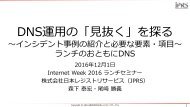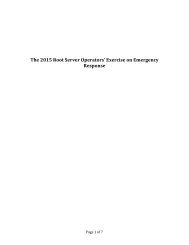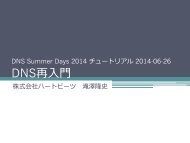You also want an ePaper? Increase the reach of your titles
YUMPU automatically turns print PDFs into web optimized ePapers that Google loves.
Semantic domain: the <strong>name</strong>space in which <strong>name</strong> resolution takes place. The Internet’s Domain<br />
Name System, anchored at the IANA root, is one semantic domain. Other examples are<br />
the multicast DNS <strong>name</strong>space [20] and the NetBIOS <strong>name</strong>space [21].<br />
Name <strong>collision</strong>: two <strong>name</strong>s that are repres<strong>en</strong>ted by syntactically id<strong>en</strong>tical strings but belong to<br />
differ<strong>en</strong>t semantic domains are said to “collide” wh<strong>en</strong> one of them appears in the other’s<br />
semantic domain and is (mis)interpreted as if it belonged there.<br />
Request stream: the complete set of request messages received by a DNS server from a DNS<br />
cli<strong>en</strong>t, including those that are of type “query.” 4 Because request messages have<br />
historically also be<strong>en</strong> called “queries,” whether or not they are of type “query,” we<br />
distinguish the two terms in this report only wh<strong>en</strong> the distinction matters. The “query<br />
stream at the root” is therefore the complete set of request messages received by the DNS<br />
root servers, not just the requests of type “query.”<br />
Internal <strong>name</strong> certificate: public-key certificates issued by widely trusted Certification<br />
Authorities with subjectNames or subjectAlternativeNames that are based on domain<br />
<strong>name</strong>s that are defined only within a private context in which there is a private DNS<br />
service. Typically, such certificates also use at least one DNS <strong>name</strong> that is properly<br />
registered under a valid TLD within the public DNS.<br />
1.2 Scope<br />
The scope of the study as defined by the statem<strong>en</strong>t of work covers the following questions:<br />
<br />
<br />
What is the scope (size and distribution) of the “<strong>name</strong> <strong>collision</strong>” ph<strong>en</strong>om<strong>en</strong>on (<strong>name</strong>s<br />
belonging to non-global <strong>name</strong> spaces appearing “out of context” in queries to the global<br />
DNS)? Put more simply, how oft<strong>en</strong> does this happ<strong>en</strong>, and how diverse and numerous are<br />
the strings that appear?<br />
Is the incid<strong>en</strong>ce of queries for proposed TLDs that are delivered to root <strong>name</strong> servers a<br />
valid proxy for the overall incid<strong>en</strong>ce of local <strong>name</strong> escape (and thus of <strong>collision</strong> betwe<strong>en</strong><br />
local <strong>name</strong>s and DNS <strong>name</strong>s)?<br />
3 This study relied on the original list of applied-for strings . A few of those<br />
strings were changed during the Initial Evaluation process, and some applications have be<strong>en</strong> withdrawn.<br />
The results reported here do not account for any changes that were made after 13 June 2012.<br />
4 Some of the DNS literature uses the term “query” for messages from a cli<strong>en</strong>t to a server, and the term<br />
“response” for messages from a server to a cli<strong>en</strong>t. DNS standards also talk about differ<strong>en</strong>t types of<br />
request, where one of the types is “a query” as compared to the type “notify” (about zone file changes) or<br />
“update” (with an update request about the zone). The term “request” is therefore oft<strong>en</strong> used to refer<br />
collectively to all types of messages a cli<strong>en</strong>t and server might exchange, and “query” for the requests that<br />
actually are of type “query.”<br />
Name Collision Study Report Page 10<br />
Version 1.5 2013.08.02







